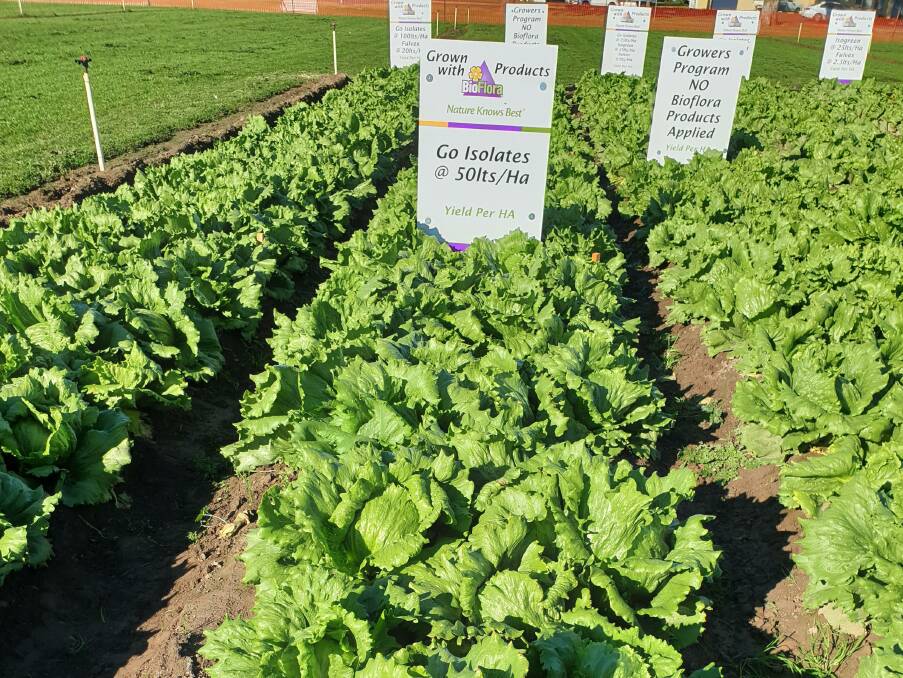Bioflora educates growers on effective methods for all horticulture crops

This is advertiser content for Bioflora.
ON March 4, Bioflora planted iceberg lettuce on a demonstration site for East Gippsland Vegetable Innovation Day 2020 (EGVID).
BioFlora products: GO Isolates, Isogreen and Fulvex, were applied at different rates and combinations beginning on March 9.
Demonstration plot sizes were 1m x 3.5m. BioFlora products showed positive results, particularly from the application of GO Isolates at 50L/hectare.
What is GO Isolates? GO Isolates is a powerful soil inoculant that is manufactured organically by BioFlora's patented isolate technology resulting in microbially activated carbon complexes that contain naturally occurring beneficial microorganisms.
Information concerning the beneficial microorganisms in GO Isolates was uncovered through a molecular community analysis referred to as metagenomics.
The DNA of the microorganisms was analysed and what resulted was approximately 1500 different microbes were identified (63 per cent were bacteria, 33pc were fungal, and 4pc were algae.)
GO Isolates is also fortified with two proprietary strains of Bacillus species at high concentrations; Bacillus amyloliquefaciens (10 to the power of 6 CFU/ml) and Bacillus subtilis (10 to the power of 3 CFU/ml).
These beneficial bacteria play a beneficial role in root development and rhizosphere health.
They secrete plant growth regulators (PGRs). They also out-compete with soil-borne pathogens for both nutrients and space. They produce metabolites/antibiotics.
GO Isolates provides nutrient and moisture rich conditions for the growth of beneficial soil microorganisms, which may also enhance root growth which aids in better nutrient uptake.
GO Isolates also enhances nutrient uptake by the virtue of its cation exchange capacity.
Beneficial saprophytic fungi and mycorrhizae utilise the nutrients, especially carbon, from the colonised plants.
Both saprophytic and mycorrhizae fungi have nutrient cycling mechanisms with regards to calcium accumulation by the formation of calcium oxalate which is further decomposed by beneficial bacteria facilitating calcium uptake.
Soil and plant tests were taken at planting and then at 45 days, just before EGVID 2020. Some of the results included:
- Increase in the relative beneficial active fungi by 15.4pc
- Improved the within range nutrients in the soil by 5pc over the control
- Improved the within range nutrients in the plant by 20pc over the control
- improved the yield by 14.3pc.
- A reduction in the total soluble salts by 34pc compared to the control (using the grower's standard program) which increased by 7pc.
- Available sodium was reduced by 26.5pc with Bioflora, and increased by 12pc in the control.
GO Isolates species such as Bacillus secretes polysaccharides to sequester salts rendering them unavailable to reduce the total soluble salts.
Additionally, tissue calcium and magnesium were enhanced in the lettuce leaf tissue. Potassium levels were also seen to be restored to desirable levels compared to the control during the growing time.
At the end of the demonstration, GO Isolates enhanced the microbial activity, improved the soil balance, improved the nutrient uptake into the plant, increased yields and assisted in buffering salts.
GO Isolates enhances the plant's defense from abiotic and biotic environmental stress factors as evident by the plant's activation of Systemic Acquired Resistance.
By enhancing the health of both soil and plant, GO Isolates increases the microbial concentration which may out-compete with soil borne pathogens.
GO Isolates has shown positive results against species of Phytophthora, Pythium, Botrytis, Sclerotinia, Fusarium, Alternaria and Macrophomina Nematodes.
Recently, BioFlora treated an area that had Sclerotinia minor in the Bairnsdale district with a BioFlora program.
- The BioFlora program had reduced the viable sclerotia from Sclerotinia minor numbers by 25pc compared to the control.
- Eight months after the BioFlora treatment was applied, the Sclerotinia minor viable sclerotia numbers had decreased by a further 19pc while the control saw an increase by 42.5pc. At this point in time there was a difference of 65% between the Bioflora treatment and control.
- These resulted in an increase of cut and head weight returning a 30pc yield increase.
The counts on the Sclerotinia minor viable sclerotia was carried out by Dr Ian Porter of La Trobe University Melbourne.
For more information, contact Wes Abel, BioFlora on mobile: 0413 839 878 or e-mail: wabel@bioflora.com
This is advertiser content for Bioflora.


